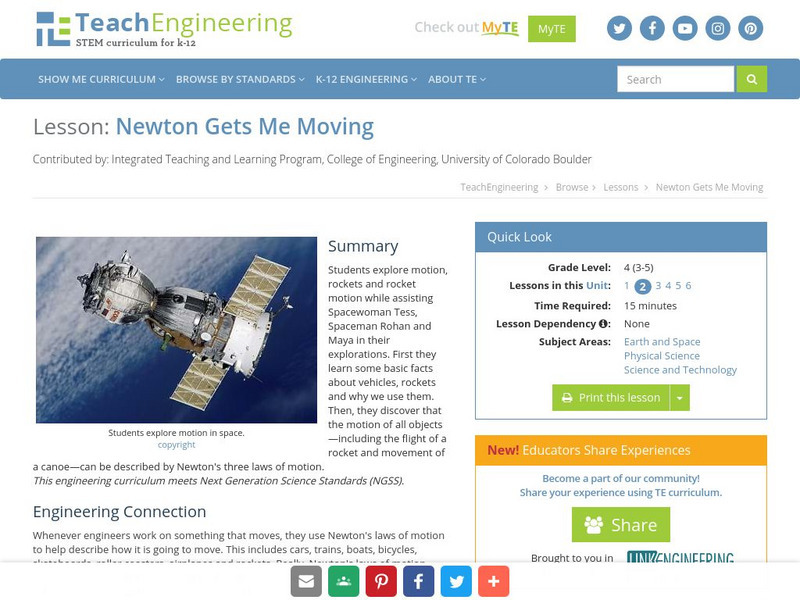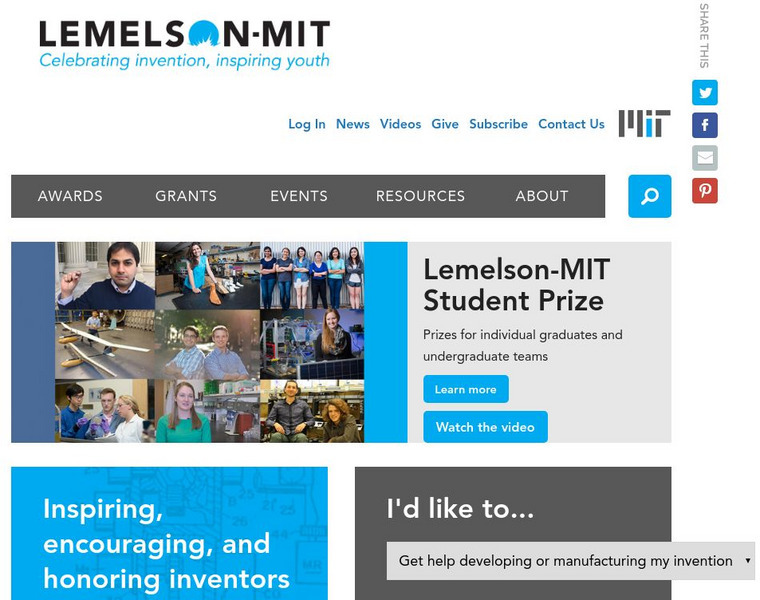Science Education Resource Center at Carleton College
Serc: The Optimal Bottle Rocket Launch
Students build rocket models designed for gaining the maximum height. They use a compressed air rocket launcher and 2-liter plastic bottles. They will also use an online simulator to help them make predictions and adjustments to their...
TED Talks
Ted: Ted Ed: Will Future Spacecraft Fit in Our Pockets?
When you picture a rocket, you might imagine a giant ship carrying lots of fuel, people and supplies. But what if the next wave of spacecraft were small enough to fit into our pockets? Dhonam Pemba details the future of microspacecraft,...
Other
Sea Launch
This corporation launches rockets for businesses interested in a cost effective, reliable solution for sending satellites into orbit. Information, images, and detailed specifications can all be found here.
NASA
Nasa: Wernher Von Braun
NASA profiles Wernher von Braun, "one of the most important rocket developers and champions of space exploration during the period between the 1930s and 1970s."
Smithsonian Institution
Nat. Air and Space Museum: Pioneers of Flight: Rockets and Dream of Spaceflight
Read about the history of rocketry and the first rocket inventors who laid the initial foundation for the development of the spaceflight industry.
TeachEngineering
Teach Engineering: Strawkets and Thrust
In this activity, students investigate the effect that thrust has on rocket flight. Students will make two paper rockets that they can launch themselves by blowing through a straw. These "strawkets" will differ in diameter, such that...
TeachEngineering
Teach Engineering: Strawkets and Weight
In this activity, students investigate the effect that weight has on rocket flight. Students construct a variety of their own straw-launched rockets, or "strawkets," that have different weights. Specifically, they observe what happens...
TeachEngineering
Teach Engineering: Strawkets and Control
In this activity, students investigate the effect that fins have on rocket flight. Students construct two paper rockets that they can launch themselves by blowing through a straw. One "strawket" has wings and the other has fins. Students...
TeachEngineering
Teach Engineering: Aqua Thrusters!
In this activity, students construct their own rocket-powered boat called an "aqua-thruster." These aqua-thrusters will be made from a film canister and will use carbon dioxide gas - produced from a chemical reaction between an antacid...
TeachEngineering
Teach Engineering: Pop Rockets
Students design and build a paper rocket around a film canister, which is used as the engine. An antacid tablet and water are put into the canister, react to form carbon dioxide gas, and act as the pop rocket's propellant. With the lid...
TeachEngineering
Teach Engineering: Rockets on a Shoestring Budget
In this activity, students revisit the Pop Rockets activity from Lesson 3. This time, however, the design of their pop-rockets will be limited by budgets and supplies. They will get a feel for the limitations of a real engineering...
TeachEngineering
Teach Engineering: Get Me Off This Planet
The purpose of this lesson is to teach students about how a spacecraft gets from the surface of the Earth to Mars. The lesson first investigates rockets and how they are able to get us into space. Finally, the nature of an orbit is...
TeachEngineering
Teach Engineering: Newton Gets Me Moving
For this lesson, students will explore motion, rockets and rocket motion while assisting Spacewoman Tess, Spaceman Rohan and Maya in their explorations. They will first learn some basic facts about vehicles, rockets and why we use them....
TeachEngineering
Teach Engineering: Rocket Me Into Space
One of the exciting challenges for engineers is the idea of exploration. This lesson looks more closely at Spaceman Rohan, Spacewoman Tess, their daughter Maya, and their challenges with getting to space, setting up satellites, and...
TeachEngineering
Teach Engineering: Blast Off
Rockets need a lot of thrust to get into space. In this instructional activity, young scholars learn how rocket thrust is generated with propellant. The two types of propellants are discussed and relation to their use on rockets is...
TeachEngineering
Teach Engineering: Learn to Build a Rocket in 5 Days or Your Money Back
In this lesson, learners discover the entire process that goes into designing a rocket for any customer. In prior lessons, students learned how rockets work, but now they learn what real-world decisions engineers have to make when...
CK-12 Foundation
Ck 12: Plix Series: Satellites, Shuttles, and Space Stations
[Free Registration/Login Required] Simulate the launch of a rocket to see how rocket propulsion works. After the activity, answer a challenge question to check for understanding.
National Museum of Science and Industry (UK)
Ingenious: Space Technology Images
This series of images is a combined collection of over three museums' collections of space technology and rocketry images. The images are sorted by pages with about nine images per page and over twenty-five pages.
Massachusetts Institute of Technology
Mit: Inventor of the Week: Robert H. Goddard
This brief article overviews the contributions Robert H. Goddard made to the development of liquid-fueled rockets.
NASA
Marshall Space Flight Center: Timeline of Rocket History
This graphical presentation includes a collection of more than 50 images and descriptions tracing rocketry from ancient times to the present day.
Science Education Resource Center at Carleton College
Serc: Mn Step: Why Does It Go So Fast? Investigating Rockets
After reading a book about movement and speed, students blow up a balloon and release it. During questioning and discussion, they are guided to make a connection between the balloon and a rocket.
PBS
Pbs Teachers: Model Rockets
Explore how the materials and shape of a rocket affect its performance. Watch kids use the scientific method to figure out how to build a model rocket that will reach 1,600 feet.
PBS
Pbs Teachers: Lift Off!
Observe kids building a model rocket. See how they use the scientific method to figure out how to make sensors for their rocket.
Michigan Reach Out
Nasa: Paper Rockets
Basic experiment allowing students to discover what gives a rocket stability.
























